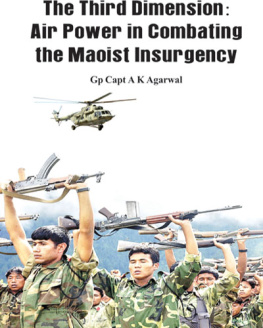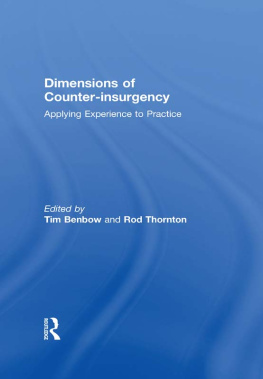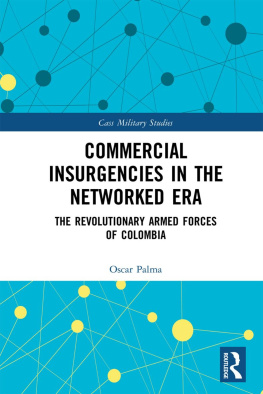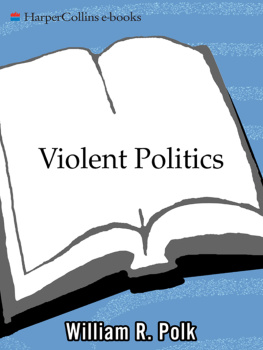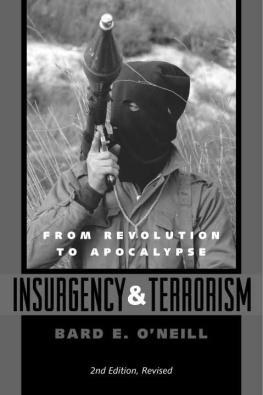Published by
Vij Books India Pvt Ltd
(Publishers, Distributors & Importers)
2/19, Ansari Road
Delhi 110 002
Phones: 91-11-43596460, 91-11-47340674
Fax: 91-11-47340674
e-mail:
Copyright 2013, United Service Institution of India, New Delhi
All rights reserved.
No part of this book may be reproduced, stored in a retrieval system, transmitted or utilized in any form or by any means, electronic, mechanical, photocopying, recording or otherwise, without the prior permission of the copyright owner. Application for such permission should be addressed to the publisher.
The views expressed in the book are of the author and not necessarily those of the USI or publishers.
Introduction
Insurgencies are born out of long periods of social discontent, economic hardships and state apathy towards the neglected masses. This discontent can result in the oppressed population being motivated to support an insurgency professing utopia in the form of an appealing ideology which will be translated into good governance by the insurgents. In due course of time the affected areas experience violence against the state machinery. If the State continuous to neglect these backward expanses, it will realise one day, that these areas are no longer governed by the law of the land but that the rule of the insurgent prevails.
The Maoist insurgency follows the well beaten path taken by most insurgencies. It was born out of the unalleviated indifference shown by States to its poor masses. This insurgency, motivated by the ideology professed by the Communists, is not a recent development. Its origin lies way back in 1947 during the Telangana struggle, initiated by the poor landless and oppressed farmers against the feudal landlords. It was nurtured through the violent efforts of the villagers of Naxalbari, a small village of West Bengal and today, it is in its prime. These poor agrarian workers and tribals, along with some educated ideologues, are greatly influenced by the ideology professed by Mao Tse Tung. The insurgents of today are aptly named Naxalites and are also known as Maoists. Yesterdays motley crowd of peasants are now organised on the lines of a regular army with an estimated strength of 8,000 to 12,000 cadres. As per the stated strategy of the Maoists, The Central task of the Indian revolution also is the seizure of political power. To accomplish this Central task, the Indian people will have to be organised in the peoples army and will have to wipe out the armed forces of the counter-revolutionary Indian state through war and will have to establish, in its place, their own state. Or in other words the insurgents are at war with the country.
This insurgency should not be taken lightly. The influence of the Maoists has spread to 182 Districts of India and is concentrated in the States of Bihar, Jharkhand, Chattisgarh, Odisha and bordering Andhra Pradesh. The insurgents have a well-established intelligence set up, motivated revolutionary soldiers who are also sufficiently armed and trained. Their operations against the security forces are well planned and rehearsed before execution, which results in a high success rate for them. The icing on the cake for them is that they have the support of the poor people, who are the centre of gravity in any insurgency. The efforts taken by the insurgents have borne fruit and they are in control of large areas of central India which they call Liberated Areas. In these areas, it is the rule of the Maoists, and not that of the Government of India, that reigns supreme.
The Central Government of India considers this insurgency to be merely a law and order problem and to be dealt with by individual states as a state subject. To assist the states, the Central Government has adopted a two-pronged strategy of security and development and created a new division called the Naxal Management Division under the Ministry of Home Affairs. This Division is mandated with effectively tackling the Naxal insurgency from both the angles of security and development.
To ensure the success of development schemes and uplifting the insurgency affected areas, a pre-requisite would be a secure and peaceful environment conducive for such development work. For creating a secure environment, 74 battalions of Central Armed Police Forces (CAPFs) and Commando Battalions for Resolute Action (CoBRA) are employed in anti-naxal operations. The government is also planning to augment the existing CAPFs with 10,000 CRPF troops.
History tells us that air power has been used extensively to quell insurgencies. The British used air power in Malaya in 1945 while the French used it in Algeria in 1954. Even India employed offensive air power in Mizoram when the Mizo National Front (MNF) declared independence from the State of India.
The role of air power in such conflicts has been rather over-looked in favour of an army and police based focus. As per a study conducted by the Rand Corporation titled Air Power in the New Counterinsurgency Era, the role of airpower is downplayed, taken for granted, or simply ignored and it (air power) is usually the last thing that most military professionals think of when the topic of counterinsurgency is discussed The main factors that influence the use of airpower in insurgencies are political will, public acceptance of the need to use aircraft and the nature and strength of the insurgency. If air power is to be used in fighting an insurgency in a democratic state, the government must convince the people that it is not using excessive force, nor is it attacking civilians indiscriminately. The government will also be embarrassed if other States can claim that it is using excessive force. It is easy to mount a false propaganda campaign castigating the government for using aircraft against the insurgents.Airpower on its own cannot defeat an insurgency which has the support of the majority of the population. The use of offensive air power against such an insurgency will only cause great bloodshed and is counterproductive for the government.
Airpower when used in support roles in counterinsurgency operations results in greater flexibility and acts to the advantage of the security forces that are otherwise at a disadvantage as compared to the insurgents who enjoy the advantage of surprise and initiative. Airpower will not be able to eliminate the requirement of having ground forces deployed in counterinsurgency operations, it will definitely enhance the ground forces ability to gather intelligence and extend their reach.
In the recent past, air power was used to transport troops during the 26/11 attack in Mumbai. There is no doubt in any ones mind that air power in non-kinetic roles can play a vital role in containing any insurgency. Accordingly, air assets are being employed against the Maoists, albeit in a limited manner. The Cabinet Committee on Security, headed by the Prime Minister, has cleared the use of helicopters only for casualty evacuation, troop mobility and other logistic roles. Helicopters have not been permitted to be used in the offensive role, though return fire in self-defence has been authorised. The availability of air assets employed in support of the security forces has been limited for various reasons. Apart from manned aircraft, UAVs have also been pressed into action for intelligence gathering. Satellite imagery is also being studied to identify areas which are cultivated by the Maoists for Opium, which helps in financing the insurgency.Intelligence inputs are vital for thwarting the designs of the insurgents. UAVs provide a method of mounting continuous and unobtrusive surveillance.

